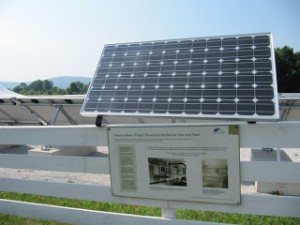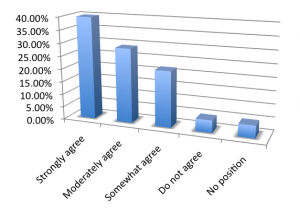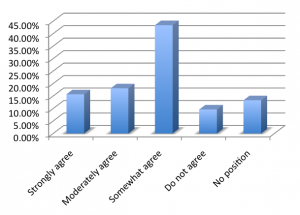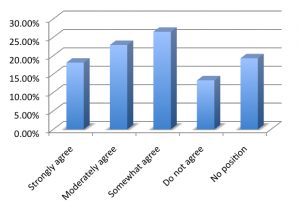How much do public historians care about issues of environmental sustainability? (Part 1)
09 December 2013 – Will Ippen

A 90-kilowatt solar array is one of the first things visitors see at Hancock Shaker Village in Pittsfield, Massachusetts. Photo credit: Cathy Stanton.
As part of its ongoing efforts to facilitate greater mutual accommodation between sustainability and public history imperatives and to better define the NCPH’s role in that process, the NCPH Task Force on Sustainability and Public History conducted an online survey during September of 2013. Responses were invited via the H-Public listserv, the weekly Public History News Update from NCPH, and this blog. The survey questions measured the level of interest in environmental sustainability among public historians across specialties, the level of interest in environmental sustainability in the greater public history community as perceived by respondents, the level to which environmental sustainability concerns were integrated into public history institutions and training programs, and respondents’ views on whether environmental sustainability should be integrated into public history education and the core values of the NCPH. As a whole, the survey suggested a significant concern over environmental sustainability in public history practice but a marked lack of institutional and educational integration. This finding reveals an unmet need which NCPH can provide leadership in rectifying–a role which respondents endorsed. Eighty-nine respondents comprised a diverse cross section of the public history community. In terms of employment, 38.4 percent work for museums, historical societies, or public history organizations; 20.9 percent for colleges or universities; 15.1 percent for government agencies; 15.1 percent are students; 8.1 percent are independent consultants; and 2.3 percent work for public history consulting firms. Virtually all responses came from IP addresses in the United States, with two originating in Canada and one in Belguim. Most respondents (70.5 percent) were current NCPH members at the time of the survey, while 12.5 percent were past members and 17 percent had never been members.
- Most public historians surveyed engage environmental sustainability at least occasionally. Over half (58.1 percent) of respondents indicated that their work in public history involves issues of environmental sustainability on occasion, while only 15.1 percent reported that their work never involves such issues. The remainder engage it about half the time (18.6 percent) or all of the time (5.8 percent).
-

Responses to the statement, “I am concerned about issues of environmental sustainability in public history practice.”
A very great majority of the respondents (90.4 percent) surveyed are at least somewhat concerned about issues of environmental sustainability in public history practice. A large plurality (39.8 percent) strongly agree with the statement “I am concerned about issues of environmental sustainability in public history practice,” while 28.9 percent moderately agree and 21.7 percent somewhat agree. Those who do not agree or hold no position on the matter comprise 4.8 percent each of the survey population.
- Respondents were asked to spell out what they see as the most pressing environmental issue facing public historians in their work. The largest share of the responses mention climate change, especially regarding its impact on historical resources. The need to incorporate sustainable practices at public history institutions–energy efficient climate control in archives, for example–also appears frequently in the responses. Several other responses mention the importance of public historians communicating to the public about the sustainability of preservation and reuse as opposed to new construction. A large number of respondents report that the relationship between public history and sustainability is unclear or that no such relationship exists.
-

Responses to the statement, “The public historians with whom I work most closely are concerned about issues of environmental sustainability in public history practice.”
Compared with the reported levels of individual concern, respondents’ perceptions of their colleagues’ interest are more muted. They still indicate a high degree of interest in the public history community, however. When asked if “the public historians with whom they work most closely are concerned about issues of environmental sustainability in public practice,” 77.2 percent at least somewhat agree with the statement. A large plurality (43.4 percent) somewhat agreed, while 18.1 percent and 15.7 percent moderately agree or strongly agree, respectively. Those taking no position or who do not agree comprise 13.3 percent and 9.6 percent of the sample, respectively. The responses to this statement taken with those to the above question imply that public historians perceive a lower level or prevalence of concern about environmental sustainability in public history practice among their colleagues than they hold as individuals. However, the results still indicate a high degree of perceived concern in the public history community.
-

Responses to the statement, “My employer or institution supports projects relating to issues of environmental sustainability in public history practice.”
Responses were roughly equal across the board when asked whether or not his or her “employer or institutions supports projects relating to issues of environmental sustainability in public history practice,” although 67.5 percent of respondents at least somewhat agree with the statement. The responses break down as follows: 18.1 percent strongly agree, 22.9 percent moderately agree, 26.5 percent somewhat agree, 13.3 percent do not agree, and 19.3 percent hold no position. These proportions do not vary significantly across different sectors except for those who disagree with the statement. Respondents from public history organizations (6 out of 28) and students (4 out of 13) disagree with the statement, suggesting a relative lack of support for projects relating to issues of environmental sustainability in those sectors. These sample sizes are too small to derive any meaningful conclusions, however. Overall, the responses suggest widely ranging levels of integration of environmental sustainability in public history practice at institutions employing public historians.
Part 2 of this series will appear on Wednesday. We invite your comments following that post.
~ Will Ippen is a PhD candidate in the Joint Doctoral Program in American History and Public History at Loyola University Chicago.




1 comment
Comments are closed.